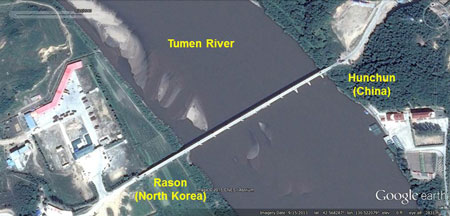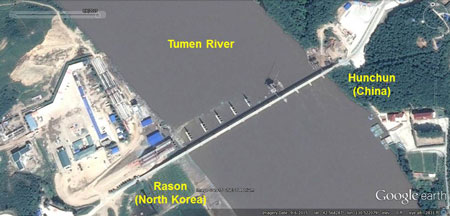The Rason Economic and Trade Zone
Continued from:
“North Korea’s Special Economic Zones: Plans vs. Progress”
The Rason Economic and Trade Zone, the DPRK’s oldest SEZ, has seen a relatively quiet two years compared to the period between 2010 and 2013.[1] During that time, two major construction projects were underway: 1) a Chinese-led road transportation project to link Rason with the Chinese city of Hunchun; and 2) a Russian-led project to refurbish the Rajin port and link it to the Russian railway network. Currently, the most significant DPRK-China cooperation project in Rason is the renovation of the Quanhe-Wonjong Bridge that links Rason with Hunchun. A Chinese construction firm has been contracted to build a four-lane bridge, to replace the current two-lane bridge some time in 2016.
Although there were persistent rumors of plans to import electricity from Hunchun to Rason, to be sold at Jilin Province rates, the project was put on hold after the 2013 nuclear test and ouster of Jang Song Thaek. It will take a significant improvement in Sino-North Korea relations for this project to be revived.
Reliable electricity supply is only one of a number of conditions necessary to attract larger Chinese companies to join the already-registered 129 foreign companies in Rason. Other conditions include being able to demonstrate a track record of improvement in the general business environment and a perception that Beijing-Pyongyang relations are stable enough for companies to manage the political risk.
New bridge construction that will improve transportation between Rason and China.
(Before: September 15, 2013; Google Earth. After: September 6, 2015; Google Earth.)
Some of the autonomy won with reforms in 2010 and 2011 has been curtailed, and over the summer of 2014, Yanji-based businesspeople who work in Rason began describing a greater degree of “negativity” towards Rason. For instance, the border immigration and registration procedures were tightened. Permissions became generally more difficult to obtain. Fundamental business inputs became scarcer. Restrictions were placed on the sale of fuel to foreign-registered vehicles, and less electricity was provided to foreign-invested companies. Unofficial payments to carry out normal tasks also increased, adding to the transaction costs of doing business in Rason. Moreover, new business licenses (or licenses for existing businesses to move into new products or fields) reportedly became more difficult to obtain for the zone as well.
To help mitigate these problems, local officials are now looking to agglomerate foreign businesses. However, forced mergers or conglomerations are often an unappealing solution as they can create inefficient pairings of industries, expertise and individuals.
While these general frustrations were brewing in 2014, they were aggravated by the Ebola quarantine, which ground many businesses to a near halt over the winter.[2] Some Chinese businesses that couldn’t bridge cash-flow shortfalls and did not have fixed capital on the ground appear to have decided against returning to the DPRK, essentially giving up on Rason.
The tightening of controls in Rason is likely connected to personnel reshufflings that took place after Jang Song Thaek’s ouster as well as bureaucratic reorganizations that have taken place in various organs of economic governance since Kim Jong Un assumed power. There is a risk of overstating the former, however. For instance, Hwang Chol Nam, the charming, English-speaking former Vice Mayor of Rason, is no longer involved in the SEZ, having been very much in the public eye for high-profile cruise trial-runs and the first trade fairs.[3] Yet further down the chain of command, most of the staff in Rason’s Economic Cooperation Bureau seems to be the same as in previous years and the bureau still cooperates with officials from Jilin Province on a Rason Joint Management Committee.
For a list of all financial institutions operating in the Rason Economic Zone, click here. For an updated list of North Korean banks, click here.
Return to last section: Unjong High-Tech Development Zone
Next section: Developments in the Smaller SEZs
- [1]
“Rason,” comprised of the two towns of Rajin and Sonbong, as well as their hinterlands, has been some form of economic zone since 1991.
- [2]
In late October, 2014, the DPRK phased in a quarantine to prevent the spread of Ebola. This eventually saw all tourism banned and all other visitors required to spend 21 days in quarantine. It was quietly lifted in March 2015.
- [3]
“N. Korea trying to attract foreign tourists,” Asahi Shimbun, August 15, 2011,
- [4]


